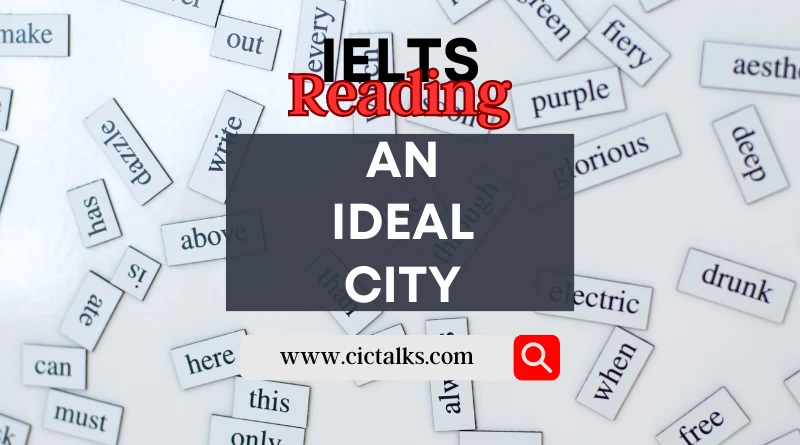An Ideal City – IELTS Reading Passage With Answers
Practice An Ideal City IELTS Academic Reading with Answers, Explanation, and PDF.
An Ideal City
READING PASSAGE
Read An Ideal City Reading Passage below. You should spend about 20 minutes on the given questions.
Leonardo da Vinci’s ideal city was centuries ahead of its time
The word ‘genius’ is universally associated with the name of Leonardo da Vinci. A true Renaissance man, he embodied scientific spirit, artistic talent, and humanist sensibilities Five hundred years have passed since Leonardo died in his home at Chateau du Clos Luce, outside Tours, France. Yet far from fading into insignificance, his thinking has carried down the centuries and still surprises today.
The Renaissance marked the transition from the 15th century to modernity and took place after the spread of the plague in the 14th century, which caused a global crisis resulting in some 200 million deaths across Europe and Asia. Today, the world is on the cusp of a climate crisis, which is predicted to cause widespread displacement, extinctions, and death, if left unaddressed. Then, as now, radical solutions were called for to revolutionize the way people lived and safeguard humanity against catastrophe.
Around 1486 – after a pestilence that killed half the population in Milan, Italy – Leonardo turned his thoughts to urban planning problems. Following a typical Renaissance trend, he began to work on an ‘ideal city’ project, which – due to its excessive costs – would remain unfulfilled. Yet given that unsustainable urban models are a key cause of global climate change today, it’s only natural to wonder how Leonardo might have changed the shape of modern cities.
Although the Renaissance is renowned as an era of incredible progress in art and architecture, it is rarely noted that the 15th century also marked the birth of urbanism as a true academic discipline. The rigour and method behind the conscious conception of a city had been largely missing in Western thought until the moment when prominent Renaissance men pushed forward large-scale urban projects in Italy, such as the reconfiguration of the town of Pienza and the expansion of the city of Ferrara. These works surely inspired Leonardo’s decision to rethink the design of medieval cities; with their winding and overcrowded streets and with houses piled against one another.
It is not easy to identify a coordinated vision of Leonardo’s ideal city because of his disordered way of working with notes and sketches. But from the largest collection of Leonardo’s papers ever assembled, a series of innovative thoughts can be reconstructed regarding the foundation of a new city along the Ticino River, which runs from Switzerland into Italy and is 248 kilometres long. He designed the city for the easy transport of goods and clean urban spaces, and he wanted a comfortable and spacious city, with well-ordered streets and architecture. He recommended ‘high, strong walls’, with towers and battlements of all necessary and pleasant beauty.
His plans for a modem and ‘rational’ city were consistent with Renaissance ideals. But, in keeping with his personality, Leonardo included several innovations in his urban design. Leonardo wanted the city to be built on several levels, linked with vertical outdoor staircases. This design can be seen in some of today’s high-rise buildings but was unconventional at the time. Indeed, this idea of taking full advantage of the interior spaces wasn’t implemented until the 1920s and 1930s, with the birth of the Modernist movement.
While in the upper layers of the city, people could walk undisturbed between elegant palaces and streets, the lower layer was the place for services, trade, transport, and industry. But the true originality of Leonardo’s vision was its fusion of architecture and engineering. Leonardo designed extensive hydraulic plants to create artificial canals throughout the city. The canals, regulated by clocks and basins, were supposed to make it easier for boats to navigate inland. Leonardo also thought that the width of the streets ought to match the average height of the adjacent houses: a rule still followed in many contemporary cities across Italy, to allow access to the sun and reduce the risk of damage from earthquakes.
Although some of these features existed in Roman cities before Leonardo’s drawings there had never been a multi-level, compact modem city that was thoroughly technically conceived. Indeed, it wasn’t until the 19th century that some of his ideas were applied. For example, the subdivision of the city by function – with services and infrastructures located in the lower levels and wide and well-ventilated boulevards and walkways above for residents – is an idea that can be found in Georges-Eugene Haussmann’s renovation of Paris under Emperor Napoleon III between 1853 and 1870.
Today, Leonardo’s ideas are not simply valid, they actually suggest a way forward for urban planning. Many scholars think that the compact city, built upwards instead of outwards, integrated with nature (especially water systems), with efficient transport infrastructure, could help modem cities become more efficient and sustainable. This is yet another reason why Leonardo was aligned so closely with modem urban planning and centuries ahead of his time.
Questions 27-33
Do the following statements agree with the information given in Reading Passage An Ideal City?
In boxes 27-33 on your answer sheet, write:
TRUE – if the statement agrees with the information
FALSE – if the statement contradicts the information
NOT GIVEN – if there is no information on this
- People first referred to Leonardo da Vinci as a genius 500 years ago.
- The current climate crisis is predicted to cause more deaths than the plague.
- Some of the challenges we face today can be compared to those of earlier times.
- Leonardo da Vinci’s ‘ideal city’ was constructed in the 15th century.
- Poor town planning is a major contributor to climate change.
- In Renaissance times, local people fought against the changes to Pienza and Ferrara.
- Leonardo da Vinci kept a neat, organised record of his designs.
Questions 34-40
Complete the summary below.
Choose ONE WORD ONLY from the passage for each answer.
Write your answers in boxes 34-40 on your answer sheet.
| Leonardo da Vinci’s ideal city |
|---|
| A collection of Leonardo da Vinci’ s paperwork reveals his design of a new city beside the Ticino River. This was to provide better 34 ……………………… for trade and a less polluted environment. Although Leonardo da Vinci’s city shared many of the ideals of his time, some of his innovations were considered unconventional in their design. They included features that can be seen in some tower blocks today, such as 35 ……………………… on the exterior of a building. Leonardo da Vinci wasn’t only an architect. His expertise in 36 ……………………… was evident in his plans for artificial canals within his ideal city. He also believed that the height of houses should relate to the width of streets in case earthquakes occurred. The design of many cities in Italy today follows this 37 ………………………. While some cities from 38 ……………………… times have aspects that can also be found in Leonardo’s designs, his ideas weren’t put into practice until long after his death. 39 ……………………… is one example of a city that was redesigned in the19th century in the way that Leonardo had envisaged. His ideas are also relevant to today’s world, where building 40 ……………………… no longer seems to be the best approach. |
An Ideal City Reading Answers
| Question | Answer |
|---|---|
| 27 | NOT GIVEN |
| 28 | NOT GIVEN |
| 29 | TRUE |
| 30 | FALSE |
| 31 | TRUE |
| 32 | NOT GIVEN |
| 33 | FALSE |
| 34 | transport |
| 35 | staircases |
| 36 | engineering |
| 37 | rule |
| 38 | Roman |
| 39 | Paris |
| 40 | outwards |
An Ideal City Answer Explanation & PDF
An Ideal City Academic Reading test evaluates a variety of reading abilities, including your capacity to follow an argument and identify a writer’s viewpoint, attitude, or intent. When reading this passage about the city architecture, it evaluates your ability to comprehend primary ideas, specifics, viewpoints, and implicit meanings.
If you have a doubt and seek an explanation to any answer whatsoever. Feel free to comment below 🙂
Tell us in the comments if you need An Ideal City Test PDF.
HERE’S ANOTHER READING PASSAGE Materials To Take Us Beyond Concrete THAT YOU MAY TRY!
ALL THE BEST!




